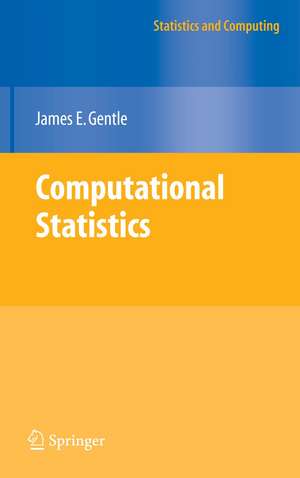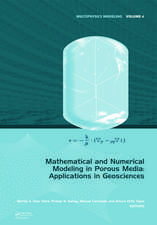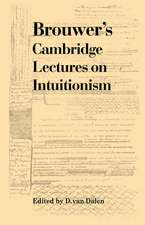Computational Statistics: Statistics and Computing
Autor James E. Gentleen Limba Engleză Paperback – 3 mar 2012
The book assumes an intermediate background in mathematics, computing, and applied and theoretical statistics. The first part of the book, consisting of a single long chapter, reviews this background material while introducing computationally-intensive exploratory data analysis and computational inference.
The six chapters in the second part of the book are on statistical computing. This part describes arithmetic in digital computers and how the nature of digital computations affects algorithms used in statistical methods. Building on the first chapters on numerical computations and algorithm design, the following chapters cover the main areas of statistical numerical analysis, that is, approximation of functions, numerical quadrature, numerical linear algebra, solution of nonlinear equations, optimization, and random number generation.
The third and fourth parts of the book cover methods of computational statistics, including Monte Carlo methods, randomization and cross validation, the bootstrap, probability density estimation, and statistical learning.
The book includes a large number of exercises with some solutions provided in an appendix.
| Toate formatele și edițiile | Preț | Express |
|---|---|---|
| Paperback (1) | 606.17 lei 6-8 săpt. | |
| Springer – 3 mar 2012 | 606.17 lei 6-8 săpt. | |
| Hardback (1) | 809.25 lei 6-8 săpt. | |
| Springer – 7 aug 2009 | 809.25 lei 6-8 săpt. |
Din seria Statistics and Computing
-
 Preț: 228.21 lei
Preț: 228.21 lei -
 Preț: 438.82 lei
Preț: 438.82 lei -
 Preț: 386.81 lei
Preț: 386.81 lei - 20%
 Preț: 753.97 lei
Preț: 753.97 lei - 20%
 Preț: 1059.77 lei
Preț: 1059.77 lei -
 Preț: 426.72 lei
Preț: 426.72 lei - 20%
 Preț: 474.37 lei
Preț: 474.37 lei - 18%
 Preț: 1387.07 lei
Preț: 1387.07 lei -
 Preț: 433.53 lei
Preț: 433.53 lei -
 Preț: 208.58 lei
Preț: 208.58 lei - 20%
 Preț: 1454.73 lei
Preț: 1454.73 lei -
 Preț: 377.18 lei
Preț: 377.18 lei - 23%
 Preț: 652.30 lei
Preț: 652.30 lei - 20%
 Preț: 1174.26 lei
Preț: 1174.26 lei - 20%
 Preț: 505.19 lei
Preț: 505.19 lei - 18%
 Preț: 959.32 lei
Preț: 959.32 lei - 15%
 Preț: 643.48 lei
Preț: 643.48 lei -
 Preț: 392.75 lei
Preț: 392.75 lei - 15%
 Preț: 640.06 lei
Preț: 640.06 lei -
 Preț: 404.29 lei
Preț: 404.29 lei - 15%
 Preț: 710.42 lei
Preț: 710.42 lei - 15%
 Preț: 695.85 lei
Preț: 695.85 lei - 20%
 Preț: 1276.86 lei
Preț: 1276.86 lei - 18%
 Preț: 1003.38 lei
Preț: 1003.38 lei - 15%
 Preț: 703.85 lei
Preț: 703.85 lei -
 Preț: 384.70 lei
Preț: 384.70 lei - 15%
 Preț: 646.94 lei
Preț: 646.94 lei - 15%
 Preț: 589.02 lei
Preț: 589.02 lei - 18%
 Preț: 1117.99 lei
Preț: 1117.99 lei -
 Preț: 503.52 lei
Preț: 503.52 lei - 18%
 Preț: 735.38 lei
Preț: 735.38 lei - 15%
 Preț: 693.90 lei
Preț: 693.90 lei
Preț: 606.17 lei
Preț vechi: 713.14 lei
-15% Nou
Puncte Express: 909
Preț estimativ în valută:
115.99€ • 121.10$ • 95.100£
115.99€ • 121.10$ • 95.100£
Carte tipărită la comandă
Livrare economică 05-19 aprilie
Preluare comenzi: 021 569.72.76
Specificații
ISBN-13: 9781461429296
ISBN-10: 1461429293
Pagini: 752
Ilustrații: XXII, 728 p.
Dimensiuni: 155 x 235 x 39 mm
Greutate: 1.03 kg
Ediția:2009
Editura: Springer
Colecția Springer
Seria Statistics and Computing
Locul publicării:New York, NY, United States
ISBN-10: 1461429293
Pagini: 752
Ilustrații: XXII, 728 p.
Dimensiuni: 155 x 235 x 39 mm
Greutate: 1.03 kg
Ediția:2009
Editura: Springer
Colecția Springer
Seria Statistics and Computing
Locul publicării:New York, NY, United States
Public țintă
ResearchCuprins
Preliminaries.- Mathematical and Statistical Preliminaries.- Statistical Computing.- Computer Storage and Arithmetic.- Algorithms and Programming.- Approximation of Functions and Numerical Quadrature.- Numerical Linear Algebra.- Solution of Nonlinear Equations and Optimization.- Generation of Random Numbers.- Methods of Computational Statistics.- Graphical Methods in Computational Statistics.- Tools for Identification of Structure in Data.- Estimation of Functions.- Monte Carlo Methods for Statistical Inference.- Data Randomization, Partitioning, and Augmentation.- Bootstrap Methods.- Exploring Data Density and Relationships.- Estimation of Probability Density Functions Using Parametric Models.- Nonparametric Estimation of Probability Density Functions.- Statistical Learning and Data Mining.- Statistical Models of Dependencies.
Recenzii
From the reviews:
“This is a book that covers many of the computational issues that statisticians will encounter as part of their research and applied work. … The writing in the book is quite clear and the author has done a good job providing the essence of each topic. … Overall, I think this is an excellent book. … This book will give a graduate student a good overview of the field. There are exercises provided for each chapter together with some solutions.” (Michael J. Evans, Mathematical Reviews, Issue 2011 b)
“This book is a superior treatment of the important subject of statistical computing. I strongly recommend this book to anyone who analyzes data using either a commercial statistical software package or statistical computer programs written by the user or someone else. Thus this book is important not only for data oriented statisticians but for econometricians, psychometricians, political methodologists and biometricians as well. … All terms in this work including computing terms are clearly defined.” (Melvin Hinich, Technometrics, Vol. 53 (1), February, 2011)
“I greatly appreciated the author’s command of both numerical and statistical computing … . The book also contains many exercises that substantiate the concepts, with solutions and hints in the appendix, an extensive bibliography, and a link to further literature and notes. The target readership includes undergraduates, postgraduates in statistics and allied fields such as computer science and mathematics, scientific research workers, and practitioners of statistics and numerical techniques. … I strongly recommend it for all scientific libraries.” (Soubhik Chakraborty, ACM Computing Reviews, October, 2010)
“This book has a very large scope in that … it covers the dual fields of computational statistics and of statistical computing. … must-read for all students and researchers engaging into any kind of serious statisticalprogramming. … is well-written, in a lively and personal style. … a reference book that should appear in the shortlist of any computational statistics/statistical computing graduate course as well as on the shelves of any researchers supporting his or her statistical practice with a significant dose of computing backup.” (Christian P. Robert, Statistical and Computation, Vol. 21, 2011)
“This is a book that covers many of the computational issues that statisticians will encounter as part of their research and applied work. … The writing in the book is quite clear and the author has done a good job providing the essence of each topic. … Overall, I think this is an excellent book. … This book will give a graduate student a good overview of the field. There are exercises provided for each chapter together with some solutions.” (Michael J. Evans, Mathematical Reviews, Issue 2011 b)
“This book is a superior treatment of the important subject of statistical computing. I strongly recommend this book to anyone who analyzes data using either a commercial statistical software package or statistical computer programs written by the user or someone else. Thus this book is important not only for data oriented statisticians but for econometricians, psychometricians, political methodologists and biometricians as well. … All terms in this work including computing terms are clearly defined.” (Melvin Hinich, Technometrics, Vol. 53 (1), February, 2011)
“I greatly appreciated the author’s command of both numerical and statistical computing … . The book also contains many exercises that substantiate the concepts, with solutions and hints in the appendix, an extensive bibliography, and a link to further literature and notes. The target readership includes undergraduates, postgraduates in statistics and allied fields such as computer science and mathematics, scientific research workers, and practitioners of statistics and numerical techniques. … I strongly recommend it for all scientific libraries.” (Soubhik Chakraborty, ACM Computing Reviews, October, 2010)
“This book has a very large scope in that … it covers the dual fields of computational statistics and of statistical computing. … must-read for all students and researchers engaging into any kind of serious statisticalprogramming. … is well-written, in a lively and personal style. … a reference book that should appear in the shortlist of any computational statistics/statistical computing graduate course as well as on the shelves of any researchers supporting his or her statistical practice with a significant dose of computing backup.” (Christian P. Robert, Statistical and Computation, Vol. 21, 2011)
Notă biografică
James E. Gentle is University Professor of Computational Statistics at George Mason University. He is a Fellow of the American Statistical Association (ASA) and of the American Association for the Advancement of Science. He has held several national offices in the ASA and has served as associate editor of journals of the ASA as well as for other journals in statistics and computing. He is author of Random Number Generation and Monte Carlo Methods and Matrix Algebra.
Textul de pe ultima copertă
Computational inference has taken its place alongside asymptotic inference and exact techniques in the standard collection of statistical methods. Computational inference is based on an approach to statistical methods that uses modern computational power to simulate distributional properties of estimators and test statistics. This book describes computationally-intensive statistical methods in a unified presentation, emphasizing techniques, such as the PDF decomposition, that arise in a wide range of methods.
The book assumes an intermediate background in mathematics, computing, and applied and theoretical statistics. The first part of the book, consisting of a single long chapter, reviews this background material while introducing computationally-intensive exploratory data analysis and computational inference.
The six chapters in the second part of the book are on statistical computing. This part describes arithmetic in digital computers and how the nature of digital computations affects algorithms used in statistical methods. Building on the first chapters on numerical computations and algorithm design, the following chapters cover the main areas of statistical numerical analysis, that is, approximation of functions, numerical quadrature, numerical linear algebra, solution of nonlinear equations, optimization, and random number generation.
The third and fourth parts of the book cover methods of computational statistics, including Monte Carlo methods, randomization and cross validation, the bootstrap, probability density estimation, and statistical learning.
The book includes a large number of exercises with some solutions provided in an appendix.
James E. Gentle is University Professor of Computational Statistics at George Mason University. He is a Fellow of the American Statistical Association (ASA) and of the American Association for the Advancement of Science. He has held several national offices in the ASA and has served as associate editor of journals of the ASA as well as for other journals in statistics and computing. He is author of Random Number Generation and Monte Carlo Methods and Matrix Algebra.
The book assumes an intermediate background in mathematics, computing, and applied and theoretical statistics. The first part of the book, consisting of a single long chapter, reviews this background material while introducing computationally-intensive exploratory data analysis and computational inference.
The six chapters in the second part of the book are on statistical computing. This part describes arithmetic in digital computers and how the nature of digital computations affects algorithms used in statistical methods. Building on the first chapters on numerical computations and algorithm design, the following chapters cover the main areas of statistical numerical analysis, that is, approximation of functions, numerical quadrature, numerical linear algebra, solution of nonlinear equations, optimization, and random number generation.
The third and fourth parts of the book cover methods of computational statistics, including Monte Carlo methods, randomization and cross validation, the bootstrap, probability density estimation, and statistical learning.
The book includes a large number of exercises with some solutions provided in an appendix.
James E. Gentle is University Professor of Computational Statistics at George Mason University. He is a Fellow of the American Statistical Association (ASA) and of the American Association for the Advancement of Science. He has held several national offices in the ASA and has served as associate editor of journals of the ASA as well as for other journals in statistics and computing. He is author of Random Number Generation and Monte Carlo Methods and Matrix Algebra.
Caracteristici
Provides a comprehensive coverage of modern computationally-intensive statistical methods Covers the topics in numerical analysis necessary for accurate and efficient implementation of the methods of computational statistics Emphasizes the unity of the methods of computational inference











